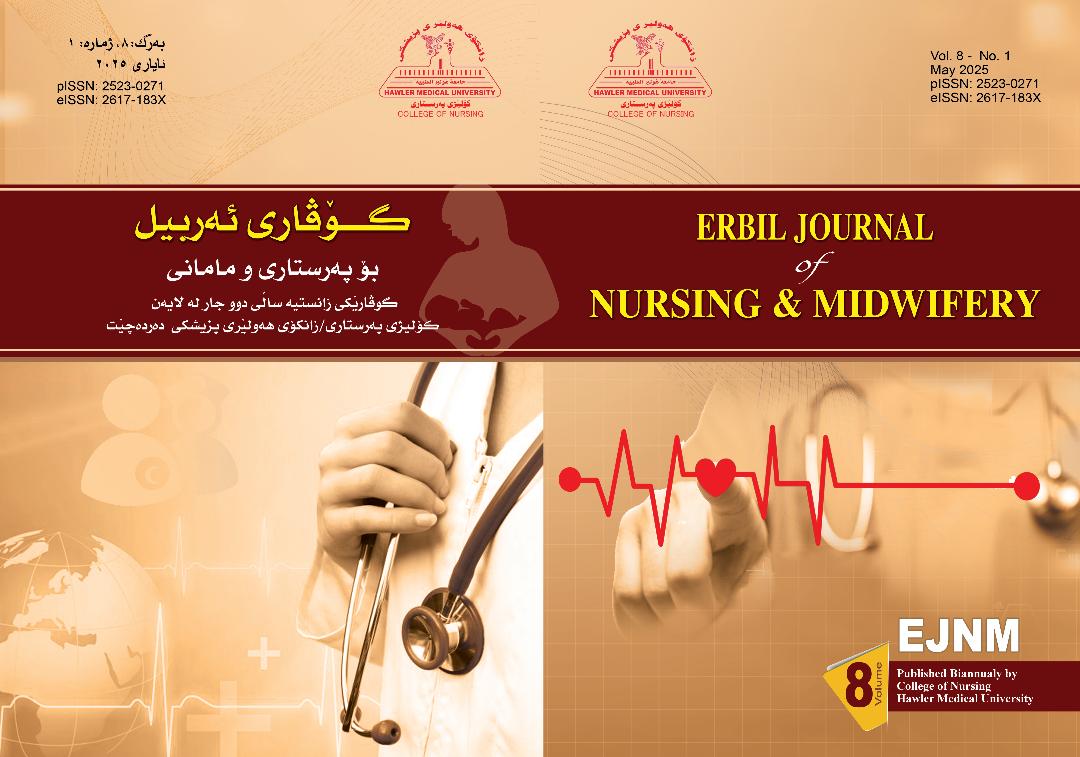Meconium-Stained Amniotic Fluid and Associated Factors among Women Undergoing Childbirth in Maternity Teaching Hospital in Erbil City
DOI:
https://doi.org/10.15218/ejnm.2025.02Keywords:
Meconium Stained, Amniotic Fluid, Risk Factors, Delivery RoomAbstract
Background and objectives: The purpose of this study was to identify the risk factors for Meconium-Stained Amniotic Fluid among women who delivered vaginally and were admitted to the delivery room at Maternity Teaching Hospital in Erbil city."
Methods: A descriptive case-control study was conducted in the labor ward of Maternity Teaching Hospital in the Kurdistan region, Iraq. The study setting was the delivery room. A non-probability purposive sample included 342 mothers with singleton pregnancies: 171 cases with Meconium-Stained Amniotic Fluid and 171 controls with clear amniotic fluid. The data were analyzed using Version 23 of the Statistical Package for the Social Sciences.
Results: The majority of women (82.7%) were illiterate, and more than half (58.2%) were multiparous. 57% of the newborns were male. Approximately 18.7% of cases had caesarean sections compared to 5.3% in the control group, which is statistically highly significant (P-value < 0.001). Additionally, about 30% of cases involving neonates were admitted to the neonatal intensive care unit, compared to just 1.8% in the control group, which is also statistically highly significant (P-value < 0.001). Postdate (B Coefficient: 2.487, 95% Confidence Interval: 4.686 to 30.854) and fetal distress (B Coefficient: 3.048, 95% Confidence Interval: 5.662 to 78.393) were highly significantly associated with Meconium-Stained Amniotic Fluid.
Conclusion: There is a highly significant association between risk factors such as postdate and fetal distress in the case-control groups. The following factors did not significantly correlate with the case-control groups: preeclampsia, premature rupture of membranes, polyhydramnios, oligohydramnios, prolonged labor, induction of labor, or spontaneous labor.
Metrics
References
Shekari, M., Jahromi, M.S., Ranjbar, A. The incidence and risk factors of meconium amniotic fluid in singleton pregnancies: an experience of a tertiary hospital in Iran. BMC Pregnancy Childbirth. 2, 930 (2022). Available from: DOI: https://doi.org/10.1186/s12884-022-05285.
Abate E, Alamirew K, Admassu E, Derbie A. Prevalence and Factors Associated with Meconium-Stained Amniotic Fluid in a Tertiary Hospital, Northwest Ethiopia: A Cross-Sectional Study. Obstetric Gynecology Inter-national Journal. 021;2021:5520117. Available from: DOI: https://doi.org/10.1155/2021/5520117.
Smruthi, C., Bhat, S., Ashwini, M.S., Kanta, S.R. and Lepakshi, B.G., A Clinical Study of Risk factors and Pregnancy outcome in women with Meconium-Stained Amniotic Fluid in labour in a Tertiary care centre. 2022. Journal of Cardiovascular Disease Research. 13 (5). Available from: DOI: Down-loadsDocuments629f3819706506.25923265_2.pdf
Gallo DM, Romero R, Bosco M, Gotsch F, Jaiman S, Jung E., et al. Meconium-stained amniotic fluid. American journal of obstetrics and gynecology. 2023 May 1;228(5): S1158-78. Available from: DOI: https://doi.org/10.1016/j.ajog.2022.11.1283
Beyene, B.N., Hirbaye, M., Kebede, A. and Balina, S., 2024. Meconium-stained amniotic fluid and associated factors among mothers who gave birth at West Guji Zone public hospitals, Oromia region, Ethiopia: A cross-sectional study. Clinical Epidemiology and Global Health. 29 (10). Available from: DOI: 10.1016/j.cegh.2024.101669.
Nirmala C, Thomas L, Sujatha Y. Risk factors of meconium stained amniotic fluid. a case control study. International Journal of Clinical Obstetrics and Gynaecology. 2020;4(2):157-60. Available from: DOI: https://doi.org/10.33545/gynae.2020.v4.i2c.521.
Sori D, Belete A, Wolde M. Meconium stained amniotic fluid: factors affecting maternal and perinatal outcomes at Jimma University specialized teaching hospital, South West Ethiopia. Gynecology and obstetrics journal (Sunnyvale). 2016;6(394):2161-0932. DOI: 10.4172/2161-0932.1000394.
Tefera M, Birhanu D, Mihretie A, Belete E, Demis A, Alemaw L. Magnitude of meconium-stained amniotic fluid and associated factors among women who gave birth in North Shoa Zone hospitals, Amhara Region, Ethiopia 2024. PLoS ONE. 19(2): e0297654. https://doi.org/10.1371/journal.pone.0297654.
Sebastian G, Ulahannan RT. Pregnancy outcome of meconium-stained amniotic fluid in uncomplicated term pregnancies: a case control study. International Journal of Academic Medicine and Pharmacy. 022;4(5):432-5. Available from: DOI: 10.47009/jamp.2022.4.5.89.
Padmapriya R, Shanmugapriya N, Shanmu-gapriya K, Sukanya E. Study on maternal risk factors and fetal outcome in deliveries with meconium-stained amniotic fluid. International Journal of Academic Medicine and Pharmacy. 2023;5(4):696-8. Available from: DOI: 10.47009/jamp.2023.5.4.138.
Awqchew S., Ezo E., Determinants of meconium aspiration syndrome among neonates admitted to neonatal intensive care unit at Nigist Eleni Mohammed Memorial Compre-hensive Specialized Hospital, South Ethiopia: Unmatched case–control study. Sage Open Medicine Journal. 2022. 10 (1). Available from: DOI: https://doi.org/10.1177/20503121221124693.
Sorsa R, Adugna T, Kene K, Abera D, Dereje D, Leta B, et al. Determinants of meconium-stained amniotic fluid among women delivered at southwestern referral hospitals, Southwest Ethiopia: a multi-centre case-control study. BMC Pregnancy and Child-birth. 2024 Oct 14;24(1):672. Available from: DOI: https://doi.org/10.1186/s12884-024-06867-4.
Gebregziabher GT, Hadgu FB, Abebe HT. Prevalence and associated factors of perinatal asphyxia in neonates admitted to Ayder Comprehensive Specialized Hospital, Northern Ethiopia: a cross-sectional study. International Journal of Pediatric. 2020;2020(1):4367248. Available from: DOI: 10.1155/2020/4367248.
Downloads
Published
How to Cite
Issue
Section
License
Copyright (c) 2025 Sazan Bahram Ahmed, Srwa Abdulrahman Mustafa, Madiha Abbas Muhammed, Kazhan Ibrahim Mahmood, Awaz Azeez Saeed (Author)

This work is licensed under a Creative Commons Attribution-NonCommercial-ShareAlike 4.0 International License.
Funding data
-
College of Nursing
Grant numbers nursing college



















